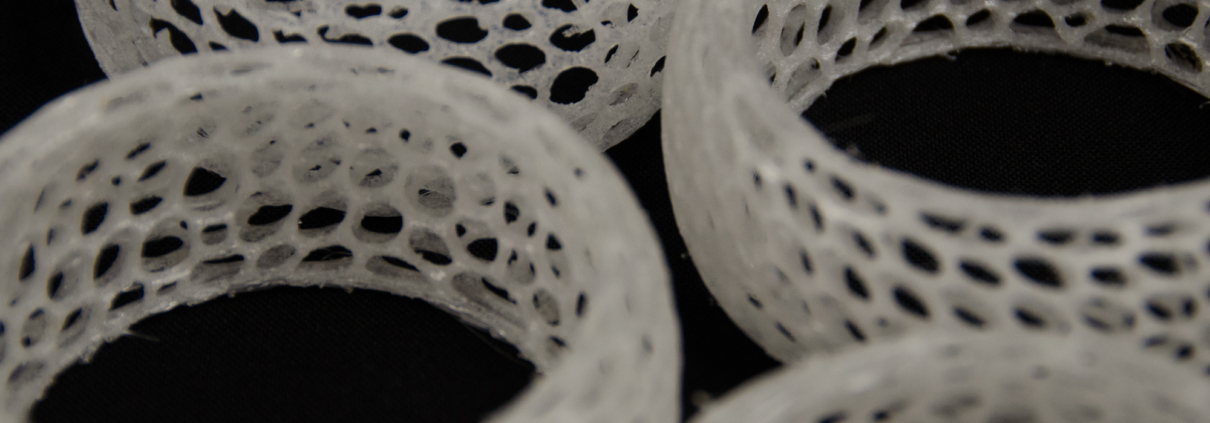3D Printing Bioresorbable Polymers for Medical Devices
“If we can expand the number of biomaterials used in additive manufacturing, we can tackle a tremendous number of problems in all fields of reconstructive surgery and make enormous strides for the benefit of patients.”
– Dr. Scott Hollister, University of Michigan1
3D-Printing. Additive manufacturing. Rapid prototyping. These buzz-phrases are always sure to attract attention at talks, conferences, on posters; you name it. Up until recently, the world of additive manufacturing was considered more niche, and some speculated the field would never realize the potential many industry leaders were suggesting. In fact, additive manufacturing has grown to become a $5.2 billion industry as of 2015, and some say total revenue could reach upwards of $20 billion by 2020 and beyond.2 Undoubtedly, 3D-printing is a disruptive technology that is still growing at an exponential rate, as more companies are beginning to adopt and reap its benefits.
While the medical field only accounts for a small fraction of the overall additive manufacturing industry, it too is finding new uses for the technology at an ever-increasing rate. Already, patients are receiving customized, 3D-printed implants and prosthetics. 3D-printing has saved the lives of numerous infants born with rare tracheal defects. Joint replacements and bone reconstruction therapies are becoming more effective due to a level of customization that simply did not exist before additive manufacturing methods. These are only a few of many medical applications developed to date.
Despite all of the medical advances employing the use of 3D-printing, medical grade materials suitable for 3D-printing are very difficult to procure. Stock polylactic acid (PLA), polycaprolactone (PCL), and acrylonitrile butadiene styrene (ABS) have been around for many years, though companies looking for medical grade 3D-printing filaments are generally out of luck. Additionally, if the goal is to develop a bioresorbable 3D-printed medical device submitted for FDA review, device manufactures have a difficult time identifying reliable, ISO-certified suppliers to pursue.
Poly-Med, a world leader in bioresorbable polymers, has taken note of the lack of materials available and will be providing medical-grade material options to the 3D-printing filament market. Our extensive polymer catalogue translates easily into the additive manufacturing materials space. And, Poly-Med’s materials are supported by an ISO 13485 certified quality system.
Poly-Med is launching its new line of 3D-printing filaments later this year. This innovative product line is set to include Lactoprene® 100M, Dioxaprene® 100M, and Maxprene® 955 as the flagship filaments, with many additional polymers set to follow in late 2017 and into 2018. These three initial filament offerings provide unique features.
Lactoprene® 100M is analogous to many standard 100% PLA filament offerings widely available, except that Lactoprene® 100M is medical grade and fully traceable. It is tailor made for 3D-printing applications involving orthopedics or for any device that requires a long-lasting, high strength material. Where faster resorption times are a design criteria, Maxprene® 955 is a good option. Maxprene® 955 is a custom 95/5 poly(glycolide-co-lactide) copolymer, boasting a high tensile modulus coupled with a shorter timeframe for strength and mass loss. Dioxaprene® 100M is a 100% polydioxanone material that has extended strength retention and also carries a degree of softness and flexibility. Dioxaprene® 100M may be appropriate when moderate degradation time is required.
Beyond these three initial offerings, Poly-Med is also evaluating translation of other bioresorbable polymers in its catalogue to 3D-printing filaments. Lactoprene® 7415, Strataprene® 3534, Caproprene® 100M, and Glycoprene® 7027 are just a few of the polymers in the 3D-printing filaments pipeline. Poly-Med is excited to be on the forefront of additive manufacturing materials and is poised to be the industry leader for bioresorbable, medical grade 3D-printing filaments. Please contact us with any questions about our 3D-printing materials or additive manufacturing developmental capabilities.
1EOS. University of Michigan reference
2Keeney, Tasha. ”3D Printing: A Disruptive Innovation Still In Its Infancy”. Ark Invest. October 2016



